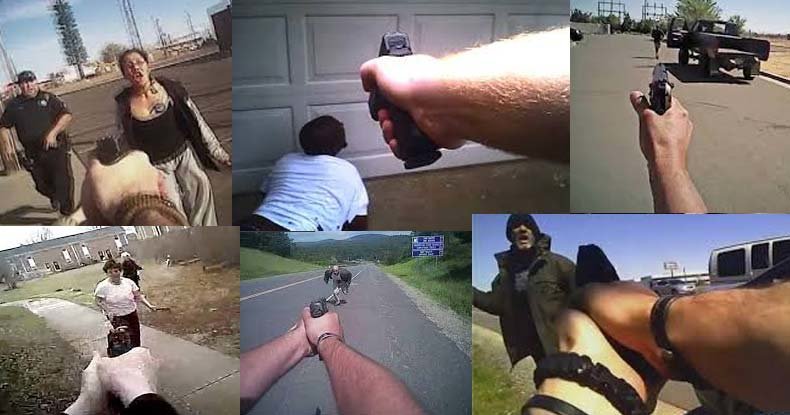Min Seok-Pang and Paul A. Pavlou of Temple University's Fox School of Business, who research "the impact of information technology on organizations," according to the Wall Street Journal, found that, in essence, calls to mandate police use of body cams could be counter-productive to reducing officer violence.
According to the researchers:
Additionally, they found body cams associated with a greater increase in fatal shootings of African Americans and Hispanics than of Asians and whites.Surprisingly, we found that the use of wearable video cameras is associated with a 3.64% increase in shooting-deaths of civilians by police. We explain that video recordings collected during a violent encounter with a civilian can be used in favor of a police officer as evidence that justifies the shooting. Aware of this evidence, the officer may become less reluctant to engage in the use of deadly force.
No such increase in deadly force occurred in 2013 and 2014 — the years the devices first came into use — because, as they posit, "It could take a while for police officers to realize how helpful evidence from body cameras could be in justifying the lethal use of force."
Interestingly, though the study found an increase in lethal use of force associated with body cams, police use of smartphones and onboard laptops to obtain intelligence like crime statistics and suspect information had the opposite effect. As they explain, "the use of smartphones by officers for intelligence access is related to 2.72% fewer deadly shootings."
To analyze the effect of technology on police use of force, researchers compiled civilian deaths by police from the Washington Post, which conservatively recorded 986 deaths in 2015, and those from killedbypolice.net for 2013 and 2014, as well as statistics on police use of technology from the Law Enforcement Management and Administration Survey published by the Department of Justice.
Their findings of the correlation of increased police deadly force with body camera use — though counter-intuitive — makes perfect sense on closer inspection.
On May 1, 2015, the DOJ announced $20 million would be allotted to expedite the use of police body-worn cameras — part of President Obama's three-year, $75 million plan to outfit 50,000 officers with the technology.
"This body-worn camera pilot program is a vital part of the Justice Department's comprehensive efforts to equip law enforcement agencies throughout the country with tools, support, and training they need to tackle the 21st century challenges we face," said Attorney General Loretta Lynch at the time. "Body-worn cameras hold tremendous promise for enhancing transparency, promoting accountability, and advancing public safety for law enforcement officers and the communities they serve."
Bureau of Justice Assistance Director Denise O'Donnell added, "Body-worn camera technology is a valuable tool for improving police-citizen relationships."
Though the researchers didn't extend their theory further, it could easily be surmised the continued lack of accountability for lethal police force, even in questionable circumstances captured by body cam video has worked to embolden police.
Rather than body cameras' intended chilling effect on the lethal use of force, when officers around the country see their colleagues act with near impunity, the accountability factor of such cameras is wholly negated.
Prosecutors often refuse to bring charges against officers — even in hotly contentious instances of lethal force — and when an indictment is levied, juries and judges frequently fail to find the officer guilty.
If accountability does not increase in tandem with video evidence, it isn't shocking such footage doesn't cause reluctance in the use of deadly force.
Further, as Mike BlueHair — co-founder of police accountability activist organization Film the Police Portland — explained in an interview with The Free Thought Project, various cities have implemented restrictive laws concerning the public release of body cam and dash cam footage. In North Carolina, for example, even police violence victims and their family members must obtain a court order to view such video — and even then, the courts aren't obligated to comply. Other localities mandate the editing of video to obscure officers' faces or other identifying information, which would be contextually vital in understanding the decision to employ lethal force.
Study authors say roughly one-quarter of departments in the U.S. now use body cams — but no national standards dictate their use. Though the Taser Corporation has developed a system in which a body cam is activated under certain conditions — such as an officer drawing a lethal or nonlethal weapon from its holster — the majority of departments using body cameras have policies regarding when officers must turn them on. This human factor — considering officers can unintentionally or purposely 'forget' to power on their cameras — has proven highly flawed.
In order for the DOJ's goal of improving civilian-police relations through the use of body-worn cameras to be effective, all of these factors must be addressed — most particularly, holding police legally and personally accountable for their actions. Until that time, body cams will increasingly be a vehicle for police to commit violence against the public with near impunity.




Comment: Body cam footage also serves another purpose: It increases fear of the police and reinforces the fact that we are living in a police state. Obey or die.